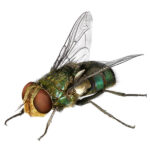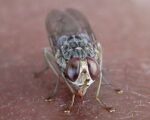A Buzzing Guide to Harare and Zimbabwe’s Common Fly Species
Have you got a problem with common fly species in Harare and Zimbabwe? Call 0772593344 for affordable, reliable and professional pest control services.
Harare, the vibrant capital of Zimbabwe, and the surrounding landscapes are home to a diverse array of fly species. From the ubiquitous housefly to the fascinating hoverflies, these buzzing creatures play vital roles in the ecosystem, both beneficial and sometimes irritating. This comprehensive guide delves into the world of Harare and Zimbabwe’s fly species, exploring their identification, behavior, and ecological significance.
Common Fly Species Found in Zimbabwe
 The housefly (Musca domestica)
The housefly (Musca domestica)
The housefly (Musca domestica)is perhaps the most familiar fly species, found in virtually every household in Harare and across Zimbabwe. These small, grey flies are easily recognized by their dark, longitudinal stripes on their thorax and their prominent, reddish-brown eyes. While they may be a nuisance buzzing around our food and homes, they are also vital scavengers, feeding on decaying organic matter and helping to break down waste.
The Blowfly: A Sign of Decay
 Blowflies (Calliphoridae) are often associated with death and decay, and for good reason. These large, metallic blue or green flies are drawn to decaying flesh, where they lay their eggs. While their presence can be unsettling, blowflies play a crucial role in the decomposition process, breaking down dead animals and returning nutrients to the soil.
Blowflies (Calliphoridae) are often associated with death and decay, and for good reason. These large, metallic blue or green flies are drawn to decaying flesh, where they lay their eggs. While their presence can be unsettling, blowflies play a crucial role in the decomposition process, breaking down dead animals and returning nutrients to the soil.
The Tsetse Fly: A Vector of Disease
 Tsetse flies (Glossina spp.) are a group of biting flies that are notorious for transmitting African trypanosomiasis, a potentially fatal disease in humans and animals. These flies are found in specific habitats, typically in forested areas and near rivers and streams, making them a concern in certain regions of Zimbabwe. Tsetse flies are easily identified by their distinctive, piercing mouthparts and their dark, reddish-brown color.
Tsetse flies (Glossina spp.) are a group of biting flies that are notorious for transmitting African trypanosomiasis, a potentially fatal disease in humans and animals. These flies are found in specific habitats, typically in forested areas and near rivers and streams, making them a concern in certain regions of Zimbabwe. Tsetse flies are easily identified by their distinctive, piercing mouthparts and their dark, reddish-brown color.
The Fruit Fly: A Tiny Menace

Fruit flies (Drosophila melanogaster), also known as vinegar flies, are a common sight in homes and gardens, particularly around ripe fruits and vegetables. These small, yellowish flies are attracted to fermenting fruit and can quickly multiply in large numbers.
While they are generally harmless, they can become pests in fruit storage areas and can transmit diseases to fruit crops.
The Hoverfly: A Master of Deception
Hoverflies (Syrphidae) are a diverse group of flies that are known for their ability to hover in mid-air. They are often mistaken for bees or wasps due to their resemblance in color and markings. However, hoverflies are harmless and actually beneficial insects, as they feed on pollen and nectar, and their larvae help control pest insects such as aphids.
Other Notable Flies
Stable flies (Stomoxys calcitrans) are biting flies that can transmit diseases, and they often attack livestock.
Horse flies (Tabanidae) are large, robust flies that are notorious for their painful bites, which can cause allergic reactions in some people.
Sand flies (Phlebotominae) are small, biting flies that can transmit leishmaniasis, a serious parasitic disease.
Understanding Flies: A Key to Control
Knowledge of the different fly species in Harare and Zimbabwe is crucial for their effective management and control. Understanding their habitats, breeding habits, and life cycles allows for targeted strategies to minimize their impact on human health and agriculture.
Key Fly Control Measures:
Professional Pest Control: At Pest Portal Zimbabwe, we offer affordable, proffessional and reliable fly control services. Call 0772593344 for the best service.
Sanitation: Proper sanitation is essential to prevent the accumulation of decaying organic matter, which attracts flies.
Insect Repellents: At Pest Potal Zimbabwe, we have repellents containing DEET or picaridin that can be effective against biting flies.
Fly Traps: At Pest Portal Zimbabwe, we have fly traps for both indoor and outdoor use. These can be effective in reducing fly populations.
Biological Control: Introducing natural predators or parasites can be an effective way to control certain fly species.
Conclusion
Harare and Zimbabwe’s fly populations are a diverse and dynamic part of the ecosystem. While some species can be pests, others are beneficial, playing vital roles in the environment. Understanding the different fly species, their behavior, and their ecological significance is crucial. This is for effective management and for ensuring a harmonious relationship between humans and these buzzing creatures. By adopting responsible practices and utilizing appropriate control measures, we can minimize the impact of flies while maintaining the balance of the ecosystem.
